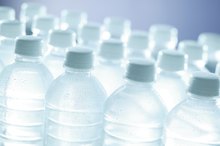Low Energy Density Foods List
Low energy density foods are those that are low in calories. In many cases, low energy density or low-calorie foods are whole, unprocessed foods, such as fruits, vegetables, very lean proteins and low-fat dairy products without added sugars. Filling your plate with low energy density foods is beneficial for weight loss.
Fruits
Fruits and vegetables are among the most nutritious and filling low energy density foods. Choose fruits that are fresh or frozen versus dried or canned in syrup or juice. Fruits contain fructose, which is fruit sugar, so they are, in general, higher in calories than vegetables. One serving of fruit is about 1 cup, or one medium-sized piece, and provides, on average, 60 to 80 calories. Examples of fruits that provide the most volume for the least amount of energy in the form of calories include peaches, nectarines, kiwi fruit, melon and berries -- such as raspberries, strawberries or blueberries.
Vegetables
Foods Containing Glucose or Fructose
Learn More
Like fruits, choose fresh or frozen vegetables, without breading or sauce. Most vegetables are lower in calories than fruits because they do not contain fructose. According to the U.S. Department of Agriculture's MyPyramid website, one serving is 1 cup, raw or cooked, for all vegetables except leafy greens. For leafy greens, the serving size is 2 cups. One serving provides, on average, less than 50 calories per cup. Examples of low energy density vegetables include asparagus, cucumber, green beans, spinach, lettuce, sweet bell peppers, radishes, onions, broccoli, cauliflower and mushrooms.
Very Lean Protein
According to the U.S. Department of Agriculture's National Nutrition Database, a 1 ounce serving of a very lean protein food provides 35 calories; far less calories than medium-fat protein foods, which provide 75 calories per ounce. Examples of low energy density protein foods include skinless turkey or chicken breast; non-fatty fish, such as tuna canned in water, flounder, sole or cod; shellfish, such as shrimp, lobster or scallops; and egg whites and/or egg substitute.
Dairy Products
What Happens to Sugar Levels in the Blood While Fasting?
Learn More
Low-fat and non-fat dairy products, such as milk and yogurt, are low energy density foods as long as they are unsweetened or sweetened with a non-nutritive sweetener in place of sugar. For example, an 8 fluid ounce cup of non-fat cow's milk or non-fat plain yogurt provides approximately 80 calories. One cup of non-fat fruited yogurt, prepared with aspartame or another non-nutritive sweetener, provides, on average, 80 to 100 calories.
Related Articles
References
Writer Bio
Michele Turcotte is a registered, licensed dietitian, and a certified personal trainer with the National Academy of Sports Medicine. She has more than 12 years of experience in clinical and corporate settings, and has extensive experience in one-on-one diet counseling and meal planning. She has written freelance food and nutrition articles for Trouve Publishing Inc. since 2004.









